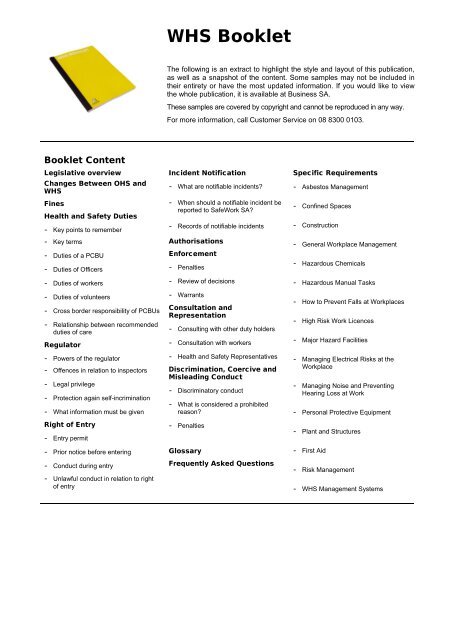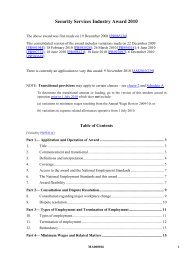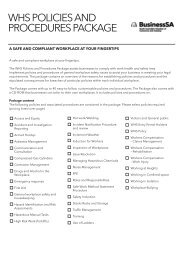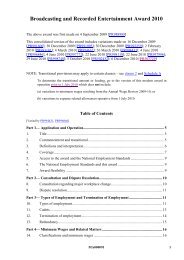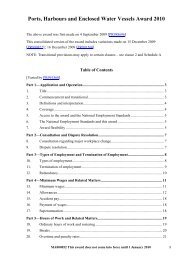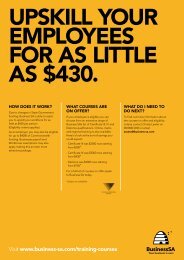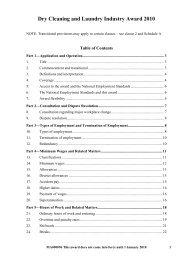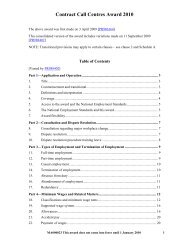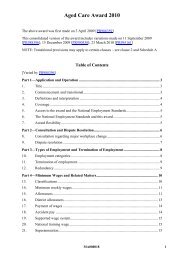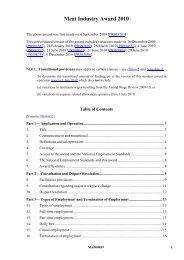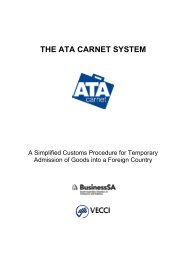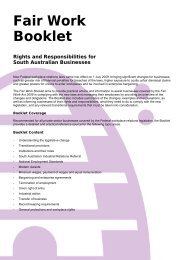WHS Booklet - Business SA
WHS Booklet - Business SA
WHS Booklet - Business SA
You also want an ePaper? Increase the reach of your titles
YUMPU automatically turns print PDFs into web optimized ePapers that Google loves.
<strong>WHS</strong> <strong>Booklet</strong>The following is an extract to highlight the style and layout of this publication,as well as a snapshot of the content. Some samples may not be included intheir entirety or have the most updated information. If you would like to viewthe whole publication, it is available at <strong>Business</strong> <strong>SA</strong>.These samples are covered by copyright and cannot be reproduced in any way.For more information, call Customer Service on 08 8300 0103.<strong>Booklet</strong> ContentLegislative overviewChanges Between OHS and<strong>WHS</strong>FinesHealth and Safety Duties- Key points to remember- Key terms- Duties of a PCBU- Duties of Officers- Duties of workers- Duties of volunteers- Cross border responsibility of PCBUs- Relationship between recommendedduties of careRegulator- Powers of the regulator- Offences in relation to inspectors- Legal privilege- Protection again self-incrimination- What information must be givenRight of Entry- Entry permit- Prior notice before entering- Conduct during entry- Unlawful conduct in relation to rightof entryIncident Notification- What are notifiable incidents?- When should a notifiable incident bereported to SafeWork <strong>SA</strong>?- Records of notifiable incidentsAuthorisationsEnforcement- Penalties- Review of decisions- WarrantsConsultation andRepresentation- Consulting with other duty holders- Consultation with workers- Health and Safety RepresentativesDiscrimination, Coercive andMisleading Conduct- Discriminatory conduct- What is considered a prohibitedreason?- PenaltiesGlossaryFrequently Asked QuestionsSpecific Requirements- Asbestos Management- Confined Spaces- Construction- General Workplace Management- Hazardous Chemicals- Hazardous Manual Tasks- How to Prevent Falls at Workplaces- High Risk Work Licences- Major Hazard Facilities- Managing Electrical Risks at theWorkplace- Managing Noise and PreventingHearing Loss at Work- Personal Protective Equipment- Plant and Structures- First Aid- Risk Management- <strong>WHS</strong> Management Systems
<strong>WHS</strong> <strong>Booklet</strong> Page 6IntroductionEvery business and individual at work is subject to legal requirements set out in workplace health and safetylegislation. The Work Health and Safety Act 2012 (<strong>SA</strong>) details these obligations for everyone in South Australianworkplaces. It is essential that businesses understand their requirements and how to manage any risks or issuesin their workplace, or they could face significant consequences.The key objective of the Work Health and Safety Act 2012 (<strong>SA</strong>) is to ensure the health and safety of workers andworkplaces, by:- protecting workers and other persons against harm to their health, safety and welfare through theelimination or minimisation of risks arising from work or from specified types of substances or plant;- providing for fair and effective workplace representation, consultation,- co-operation and issue resolution in relation to work health and safety;- encouraging unions and employer organisations to take a constructive role in promoting improvements inwork health and safety practices, and assisting persons conducting businesses or undertakings andworkers to achieve a healthier and safer working environment;- promoting the provision of advice, information, education and training in relation to work health and safety;- securing compliance with this Act through effective and appropriate compliance and enforcementmeasuresDespite the original aim of trying to create a single set of harmonised laws for all of Australia, there are stilldifferent sets of <strong>WHS</strong> legislation across Australia.Each State or Territory in Australia has safety laws that are administered by the state or territory regulator, most ofthese are modeled on the national model <strong>WHS</strong> legislation.This <strong>Booklet</strong> is designed to give you a snapshot of what <strong>WHS</strong> is and the obligations on businesses (now referredto as persons conducting a business or undertaking). This <strong>Booklet</strong> provides businesses with an overview to helpunderstand and comply with their <strong>WHS</strong> obligations. There is practical guidance, examples and explanations of keyaspects of the legislation, along with information on some specific areas of <strong>WHS</strong>.Legislative overviewThe <strong>WHS</strong> laws replace the South Australian Occupational Health, Safety and Welfare Act 1986 and theOccupational Health, Safety and Welfare Regulations 2010.<strong>WHS</strong> is made of three key parts of legislation: the Act, and the Regulations, supported by a range of Codes ofPractices. Combined, these make up the legally enforceable obligations of everyone involved and subject to workhealth and safety. <strong>Business</strong>es must make sure they are meeting all of their legal requirements, or face possiblepenalties.The Act sets the overall framework, duties, responsibilities and compliance measures.The Regulations provide detailed instructions and directives. The Codes of Practice are intended to providepractical guidance to assist compliance with the Act. Codes of Practice that are written into the Regulations aremandatory, and form part of those Regulations.© Copyright/DisclaimerJanuary 2013
<strong>WHS</strong> <strong>Booklet</strong> Page 32Work Health and Safety DutiesUnder the <strong>WHS</strong> Act, everyone in the workplace has a duty. These will differ depending on the level ofresponsibility associated with each person and their work. For example, a CEO will have a different set of dutiescompared to a receptionist or administration staff.There are specific duties outlined for PCBUs, officers, government departments, workers and other people in theworkplace.What does this mean?This means businesses need to have a clear understanding of the duties and responsibilities of everyone in theworkplace, as well as what the business is required to provide under the <strong>WHS</strong> legislation.Where a person has a duty to ensure health and safety, this means they are required to:- eliminate risks to health and safety as far as reasonably practicable;Or, if this is not possible:- minimise the risks to health and safety so far as is reasonably practicable.Key points to remember- The PCBU is the main ‘duty holder’ in making sure work health and safety is maintained.- The responsibility to ensure that the PCBU complies with its responsibilities rests with the ‘officers’ of thePCBU.- Officers must exercise ‘due diligence’ to ensure that the PCBU complies with its duties.- No work health and safety duties can be transferred to another person or PCBU (e.g. an Officer cannottransfer their duties to the PCBU or a worker).- The duty to ensure work health and safety extends to what is reasonably practicable.- A person or business can hold more than one duty.- Where this happens, each person has to carry out their duty, or duties, to the level where they havethe capacity to influence and control the matter (e.g. a PCBU manufacturing chemicals has duties asa manufacturer, and duties as a PCBU to its own workers)...© Copyright/DisclaimerJanuary 2013
<strong>WHS</strong> <strong>Booklet</strong> Page 32Discrimination, Coercive and MisleadingConductUnder <strong>WHS</strong> some conduct is considered to be discriminatory. It is against the law to engage in discriminatoryconduct for a prohibited reason. The aim of this is to effectively allow workers and prospective workers the right toperform allowed safety-related functions or activities and to raise any workplace health and safety issues withoutfear of retribution.Discriminatory conductIt is people who are considered to be workers or prospective workers under the <strong>WHS</strong> legislation that are protectedby the unlawful act of discriminatory conduct. Conduct that is considered discriminatory involves treating someoneto their disadvantage in their position, prospective position or work arrangements.A person engages in discriminatory conduct if they:- dismiss a worker;- terminate a contract for services with a worker;- put a worker to his or her detriment in the engagement of the worker;- alter the position of the worker to their detriment;- refuse or fail to offer to engage a prospective worker;- treat a prospective worker less favourably than another prospective worker would be treated in offeringterms of engagement;- terminate a commercial arrangement with another person; or- refuse or fail to enter into a commercial arrangement with another person.Discriminatory conduct also includes taking action or threatening to take action referred to above. A person mustnot induce or coerce another person to do the above things...© Copyright/DisclaimerJanuary 2013
<strong>WHS</strong> <strong>Booklet</strong> Page 76First AidDefinitions“First aid” is the immediate treatment or care given to a person suffering from an injury or illness until moreadvanced care is provided or the person recovers.First aider” is a person who has successfully completed a nationally accredited training course or an equivalentlevel of training that has given them the competencies required to administer first aid.“First aid equipment” includes first aid kits and other equipment used to treat injuries and illnesses.“First aid facilities” include first aid rooms, health centres, clean water supplies and other facilities needed foradministering first aid.“High risk workplace” means a workplace where workers are exposed to hazards that could result in seriousinjury or illness and would require first aid.“Low risk workplace” means a workplace where workers are not exposed to hazards that could result in seriousinjury or illness such as offices, shops or libraries. Potential work-related injuries and illnesses requiring first aidwould be minor in nature.What do PCBUs need to do?When considering how to provide first aid, a PCBU must:1. Consider all relevant issuesTake into account all relevant matters, which includes:- the nature of work being carried out at the workplace;- the nature of hazards at the workplace;- the size, location and nature of the workplace; and- the number and composition of workers at the workplace.2. First aid roomWorkplaces need to conduct a risk assessment to see whether they need to have a dedicated first aidroom...© Copyright/DisclaimerJanuary 2013
<strong>WHS</strong> <strong>Booklet</strong> Page 85GlossaryWhere possible, these definitions have been taken from South Australia’s <strong>WHS</strong> legislation directly.Code of PracticeCodes of Practice provide advice on how to comply with <strong>WHS</strong> requirements. They are not mandatory and a dutyholder may choose to use another way to achieve compliance. However, if you do not follow the Code of Practice,you will have to prove what you did was of an equivalent standard or higher level than the Code of Practice.Non-compliance with a Code of Practice can be used as evidence in legal proceedings.Due DiligenceOfficers of a PCBU must exercise due diligence to ensure the PCBU complies with duties or obligations under thelegislation. Due diligence includes taking reasonable steps to:Duty- acquire and keep up-to-date knowledge of work health and safety matters;- gain an understanding of the nature of the operations of the business or undertaking of the PCBU andgenerally of the hazards and risks associated with those operations;- ensure that the PCBU has available for use, and uses, appropriate resources and processes to eliminateor minimise risks to health and safety from work carried out as part of the conduct of the business orundertaking;- ensure that the PCBU has appropriate processes for receiving and considering information regardingincidents, hazards and risks and responding in a timely way to that information (e.g. reporting notifiableincidents, consulting with workers, etc.);- ensure that the PCBU has, and implements, processes for complying with any duty or obligation of thePCBU; and- verifying the provision and use of the resources and processes referred to in the above three points.A duty is a legal obligation that requires mandatory conduct or performance. A duty cannot be transferred toanother person. A health and safety duty is a duty that is defined in Division 2, 3 or 4 of the <strong>WHS</strong> Act…© Copyright/DisclaimerJanuary 2013


